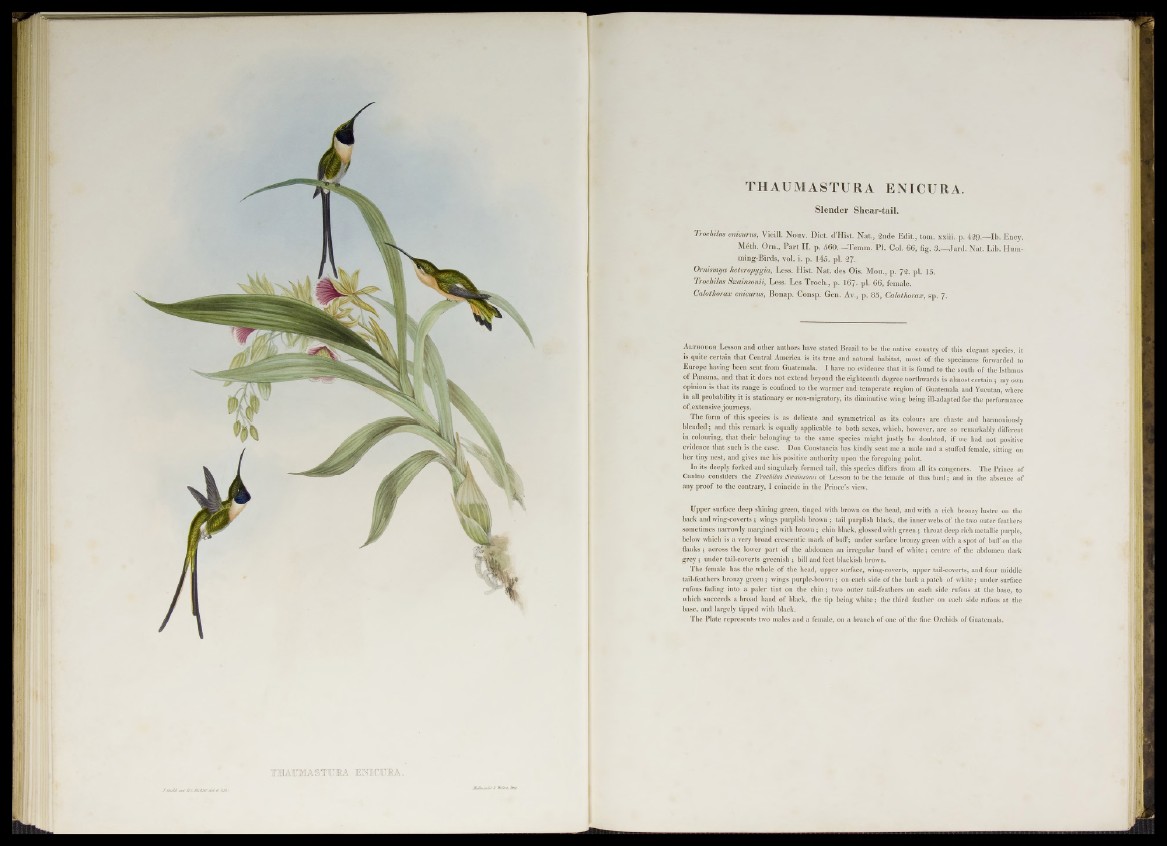
THAUMASTURA ENICURA.
Slender Shear-tail.
Trochilus enicurm, Vieill. Nouv. Diet. d’Hist. Nat., 2ade Edit., tom. xxiii. p. 429. lb. Ency.
M&h. Orn., Part II. p. 560. -T em m . PI. Col. 66, fig. 3.—Jard. Nat. Lib. Humming
Birds, vol. i. p. 145. pi. 27.
Ornismya heteropygict, Less. H ist Nat. des Ois. Mou., p. 72. pi. 15.
Trochilus Swaimonii, Less. Les Troch., p. 167. pi. 66, female.
Calothorax enicurm, Bonap. Consp. Gen. Av., p. 85, Calothorax, sp. 7.
A l t h o u g h Lesson and other authors have stated Brazil to be the native country of this elegant species, it
is quite certain that Central America is its true and natural habitat, most of the specimens forwarded to
Europe having been sent from Guatemala. I have no evidence that it is found to the south of the Isthmus
of Panama, and that it does not extend beyond the eighteenth degree northwards is almost certain ; my own
opinion is that its range is confined to the warmer and temperate region of Guatemala and Yucutan, where
in all probability it is stationary or non-migratory, its diminutive wing being ill-adapted for the performance
of extensive journeys.
The form of this species is as delicate and symmetrical as its colours are chaste and harmoniously
blended; and this remark is equally applicable to both sexes, which, however, are so remarkably different
in colouring, that their belonging to the same species might justly be doubted, if we had not positive
evidence that such is the case. Don Constancia has kindly sent me a male and a stuffed female, sitting on
her tiny nest, and gives me his positive authority upon the foregoing point.
In its deeply forked and singularly formed tail, this species differs from all its congeners. The Prince of
Canino considers the Trochilus Sioamsonii of Lesson to be the female of this bird; and in the absence of
any proof to the contrary, I coincide in the Prince’s view.
Upper surface deep shining green, tinged with brown on the head, and with a rich bronzy lustre on the
back and wing-coverts ; wings purplish brown ; tail purplish black, the inner webs of the two outer feathers
sometimes narrowly margined with brown; chin black, glossed with green; throat deep rich metallic purple,
below which is a very broad crescentic mark of buff; under surface bronzy green with a spot of buff on the
flauks ; across the lower part of the abdomen an irregular band of white; centre of the abdomen dark
grey ; under tail-coverts greenish ; bill and feet blackish brown.
The female has the whole of the head, upper surface, wing-coverts, upper tail-coverts, and four middle
tail-feathers bronzy green; wings purple-brown j on each side of the back a patch of white; under surface
rufous fading into a paler tint on the chin ; two outer tail-feathers on each side rufous at the base, to
which succeeds a broad band of black, die tip being white; the third feather on each side rufous at the
base, and largely tipped with black.
The Plate represents two males and a female, on a branch of one of the fine Orchids of Guatemala.